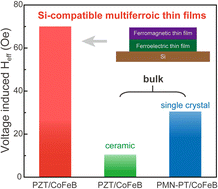Large in-plane piezo-strain enhanced voltage control of magnetic anisotropy in Si-compatible multiferroic thin films†
Abstract
Voltage control of magnetic anisotropy (VCMA) in Si-compatible ferroelectric/ferromagnetic multiferroic thin films is promising to enable power-efficient and integrated magnetic memories. However, their VCMA effect is weak and is always smaller than that of the bulk counterparts. Here, we achieve a more substantial VCMA effect in thin films than in the bulk, benefiting from the large in-plane piezo-strain mediated magnetoelectric coupling under strong fields. Si-compatible ferroelectric Pb(Zr,Ti)O3 (PZT) thin films with large breakdown strength of up to 3.2 MV cm−1 are fabricated to further construct multiferroic thin films. Since conventional methods fail to measure the VCMA effect under strong fields, we establish a micro-ferromagnetic resonance method based on micro-fabrication. An enhanced VCMA effect is demonstrated in PZT/CoFeB thin films, whose voltage-induced effective magnetic field (Heff) could experimentally reach 26.1 Oe, which is much stronger than that in bulk control samples “PZT ceramic/CoFeB” (2.6 Oe) and “PMN-PT single crystal/CoFeB” (18.5 Oe) as well as previous reports. Theoretically, the Heff in thin films could be > 60 Oe near the breakdown strength, resulting from a giant in-plane piezo-strain S31 < −0.3%, which is comparable to that of the best ferroelectric single crystals. Si-compatible multiferroic thin films with enhanced VCMA will be a useful platform for developing integrated magnetic and spintronic devices.



 Please wait while we load your content...
Please wait while we load your content...